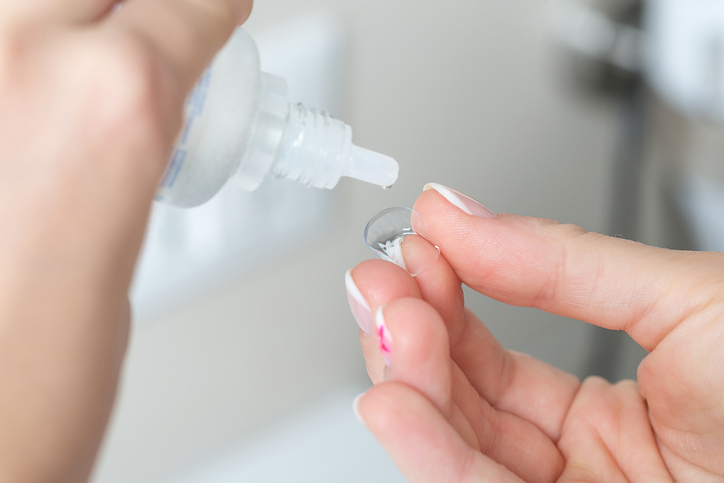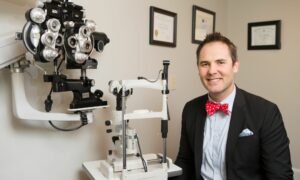By Cheryl G. Murphy, OD,

August 23, 2017
Dropouts from contact lens wear have long hindered the growth of the segment, but ODs hold the potential to change that for the better. The key is to address the number-one cause of dropouts, discomfort–and to offer simple solutions. Or rather, to simplify the solutions, that is, contact lens care solutions.
Visit the CL solutions aisle at retail and see what consumers (your patients) see. Also, make the contact lens storage case a part of the discussion, and proactively give out cases to promote their frequent replacement.
By keeping current with contact lens solutions on the market, and digging deeper into our patients’ contact lens routines, we can decrease contact lens dropouts, and the risk of infection, while increasing patient retention, trust and the “wow” factor.
If you’re like me at the grocery store, you breeze past the eyecare aisle. After all, as optometrists we think we already know about the latest and greatest in contact lens solutions. But should we be paying closer attention to not only lectures on the newest stuff, but also what is still being offered to our patients in the eyecare aisle?
I have to admit, like many ODs, I prescribe so many daily disposable lenses that I worry about contact lens solutions a lot less than I used to. I also tend to prescribe hydrogen peroxide-based solutions for a more thorough clean whenever possible. However, when I popped down the eyecare aisle in my local grocery store recently, I was surprised by what I found.
Multiple Generations (and Versions) of Multi-Purpose Solutions For Sale
When a company comes out with a new multi-purpose contact lens solution, it doesn’t mean they have discontinued their old one (or even the one prior to that for that matter!).
This discovery confirmed a longstanding suspicion of mine: when we recommend or “prescribe” a new, or particular contact lens solution customized to what we think will best meet the patient’s needs, it doesn’t mean they are going to stick with what we suggested when they get to the eyecare aisle. For that reason, we should not rely on our notes of what samples of solution we dispensed, or what we recommended the patient use, to give us the right information about a patient’s regimen of care. Instead we should have the patient bring in what they are currently using, and any contact lens care “paraphernalia” they are using at home, so that we can look at these as part of their yearly contact lens re-evaluation. This includes cases, solutions, rinses, enzymatic cleaners and re-wetting drops.
Make the Case for a Properly Cleaned Case
In addition to having patients bring in all products they are using to care for their eyes and contacts, it’s important to also ask the patient to bring in their contact lens case. Only a couple of times have I gotten a case that looked so old and grimy that I was tempted to culture what was growing inside it, but it’s still good to check. I urge all practitioners to consider doing this. One may be surprised by the level of “yuck” one can find, and it will make for an educational moment.
Asking how often patients replace their contact lens cases takes little time on our part, and helps to decrease our patients’ risk of infection. They should be replacing their contact lens cases on a regular basis, “just like your toothbrush” is the phrase I use with my patients. I can’t tell you how many patients have said to me that I am the first person to ever tell them that. Stand out from the eyecare practitioners who may not be telling their patients to change their cases, and take a few seconds to educate your patients on this important issue before things turn “icky,” and even dangerous to eye health.
The American Dental Association recommends patients replace their toothbrush every 3-4 months, and the American Optometric Association recommends patients replace their contact lens cases every three months, but I tell patients to replace it every 6-8 weeks in hopes that even if they procrastinate, they’ll still wind up with a fresh one on time. I also tell them that, similar to their toothbrush, they should throw out their contact lens case and start with a fresh, new one if they get sick with a cold, cough or the flu.
In the grocery aisle I visited they were selling individually packed, replacement contact lens cases for $2.99 a piece. Make your patients day and give them a couple extra at their yearly contact lens re-evaluation. Or invite them to stop in the office anytime for a free one when they need it. A little courtesy goes a long way.
By taking the time to assess our patients’ contact lens solutions, cases and routine we can build trust, success and the “wow” factor in our contact lens patients. The “wow” in this case, being: “Wow, how come I have never been asked (or told) that before?”
Do you ask your patients to bring in all the products they use for their eyes and contacts, along with their contact lens cases? How do you educate your patients about the importance of using specific contact lens solutions, and replacing contact lens cases on a regular basis?
 Cheryl G. Murphy, OD, practices in Glen Cove, Syosset and Lake Ronkonkoma, N.Y. You can like her on Facebook or follow her on Twitter @murphyod. To contact her: murphyc2020@gmail.com.
Cheryl G. Murphy, OD, practices in Glen Cove, Syosset and Lake Ronkonkoma, N.Y. You can like her on Facebook or follow her on Twitter @murphyod. To contact her: murphyc2020@gmail.com.

























